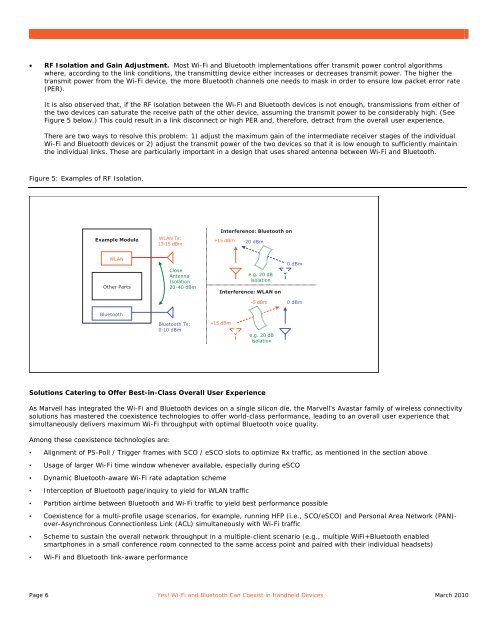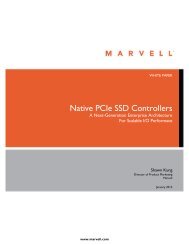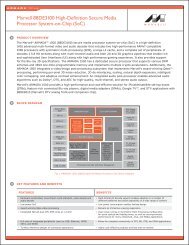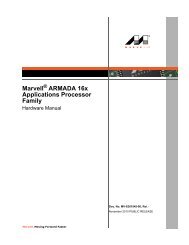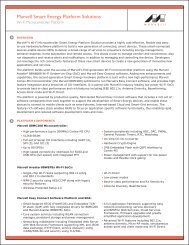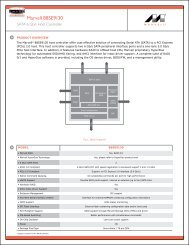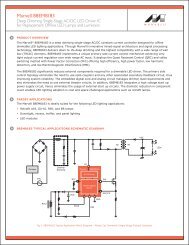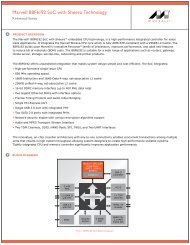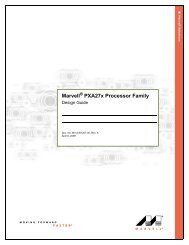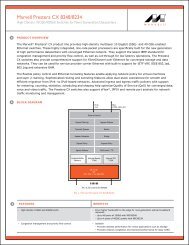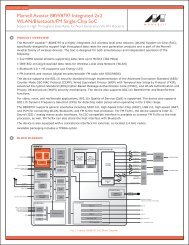Yes! Wi-Fi and Bluetooth Can Coexist in Handheld Devices
Yes! Wi-Fi and Bluetooth Can Coexist in Handheld Devices - Marvell
Yes! Wi-Fi and Bluetooth Can Coexist in Handheld Devices - Marvell
You also want an ePaper? Increase the reach of your titles
YUMPU automatically turns print PDFs into web optimized ePapers that Google loves.
• RF Isolation <strong>and</strong> Ga<strong>in</strong> Adjustment. Most <strong>Wi</strong>-<strong>Fi</strong> <strong>and</strong> <strong>Bluetooth</strong> implementations offer transmit power control algorithms<br />
where, accord<strong>in</strong>g to the l<strong>in</strong>k conditions, the transmitt<strong>in</strong>g device either <strong>in</strong>creases or decreases transmit power. The higher the<br />
transmit power from the <strong>Wi</strong>-<strong>Fi</strong> device, the more <strong>Bluetooth</strong> channels one needs to mask <strong>in</strong> order to ensure low packet error rate<br />
(PER).<br />
It is also observed that, if the RF isolation between the <strong>Wi</strong>-<strong>Fi</strong> <strong>and</strong> <strong>Bluetooth</strong> devices is not enough, transmissions from either of<br />
the two devices can saturate the receive path of the other device, assum<strong>in</strong>g the transmit power to be considerably high. (See<br />
<strong>Fi</strong>gure 5 below.) This could result <strong>in</strong> a l<strong>in</strong>k disconnect or high PER <strong>and</strong>, therefore, detract from the overall user experience.<br />
There are two ways to resolve this problem: 1) adjust the maximum ga<strong>in</strong> of the <strong>in</strong>termediate receiver stages of the <strong>in</strong>dividual<br />
<strong>Wi</strong>-<strong>Fi</strong> <strong>and</strong> <strong>Bluetooth</strong> devices or 2) adjust the transmit power of the two devices so that it is low enough to sufficiently ma<strong>in</strong>ta<strong>in</strong><br />
the <strong>in</strong>dividual l<strong>in</strong>ks. These are particularly important <strong>in</strong> a design that uses shared antenna between <strong>Wi</strong>-<strong>Fi</strong> <strong>and</strong> <strong>Bluetooth</strong>.<br />
<strong>Fi</strong>gure 5: Examples of RF Isolation.<br />
Example Module<br />
WLAN Tx:<br />
13-15 dBm<br />
Interference: <strong>Bluetooth</strong> on<br />
+15 dBm<br />
-20 dBm<br />
WLAN<br />
Other Parts<br />
Close<br />
Antenna<br />
Isolation<br />
20-40 dBm<br />
e.g. 20 dB<br />
isolation<br />
Interference: WLAN on<br />
0 dBm<br />
-5 dBm 0 dBm<br />
<strong>Bluetooth</strong><br />
<strong>Bluetooth</strong> Tx:<br />
0-10 dBm<br />
+15 dBm<br />
e.g. 20 dB<br />
isolation<br />
Solutions Cater<strong>in</strong>g to Offer Best-<strong>in</strong>-Class Overall User Experience<br />
As Marvell has <strong>in</strong>tegrated the <strong>Wi</strong>-<strong>Fi</strong> <strong>and</strong> <strong>Bluetooth</strong> devices on a s<strong>in</strong>gle silicon die, the Marvell’s Avastar family of wireless connectivity<br />
solutions has mastered the coexistence technologies to offer world-class performance, lead<strong>in</strong>g to an overall user experience that<br />
simultaneously delivers maximum <strong>Wi</strong>-<strong>Fi</strong> throughput with optimal <strong>Bluetooth</strong> voice quality.<br />
Among these coexistence technologies are:<br />
• Alignment of PS-Poll / Trigger frames with SCO / eSCO slots to optimize Rx traffic, as mentioned <strong>in</strong> the section above<br />
• Usage of larger <strong>Wi</strong>-<strong>Fi</strong> time w<strong>in</strong>dow whenever available, especially dur<strong>in</strong>g eSCO<br />
• Dynamic <strong>Bluetooth</strong>-aware <strong>Wi</strong>-<strong>Fi</strong> rate adaptation scheme<br />
• Interception of <strong>Bluetooth</strong> page/<strong>in</strong>quiry to yield for WLAN traffic<br />
• Partition airtime between <strong>Bluetooth</strong> <strong>and</strong> <strong>Wi</strong>-<strong>Fi</strong> traffic to yield best performance possible<br />
• <strong>Coexist</strong>ence for a multi-profile usage scenarios, for example, runn<strong>in</strong>g HFP (i.e., SCO/eSCO) <strong>and</strong> Personal Area Network (PAN)-<br />
over-Asynchronous Connectionless L<strong>in</strong>k (ACL) simultaneously with <strong>Wi</strong>-<strong>Fi</strong> traffic<br />
• Scheme to susta<strong>in</strong> the overall network throughput <strong>in</strong> a multiple-client scenario (e.g., multiple <strong>Wi</strong><strong>Fi</strong>+<strong>Bluetooth</strong> enabled<br />
smartphones <strong>in</strong> a small conference room connected to the same access po<strong>in</strong>t <strong>and</strong> paired with their <strong>in</strong>dividual headsets)<br />
• <strong>Wi</strong>-<strong>Fi</strong> <strong>and</strong> <strong>Bluetooth</strong> l<strong>in</strong>k-aware performance<br />
Page 6 <strong>Yes</strong>! <strong>Wi</strong>-<strong>Fi</strong> <strong>and</strong> <strong>Bluetooth</strong> <strong>Can</strong> <strong>Coexist</strong> <strong>in</strong> H<strong>and</strong>held <strong>Devices</strong> March 2010


